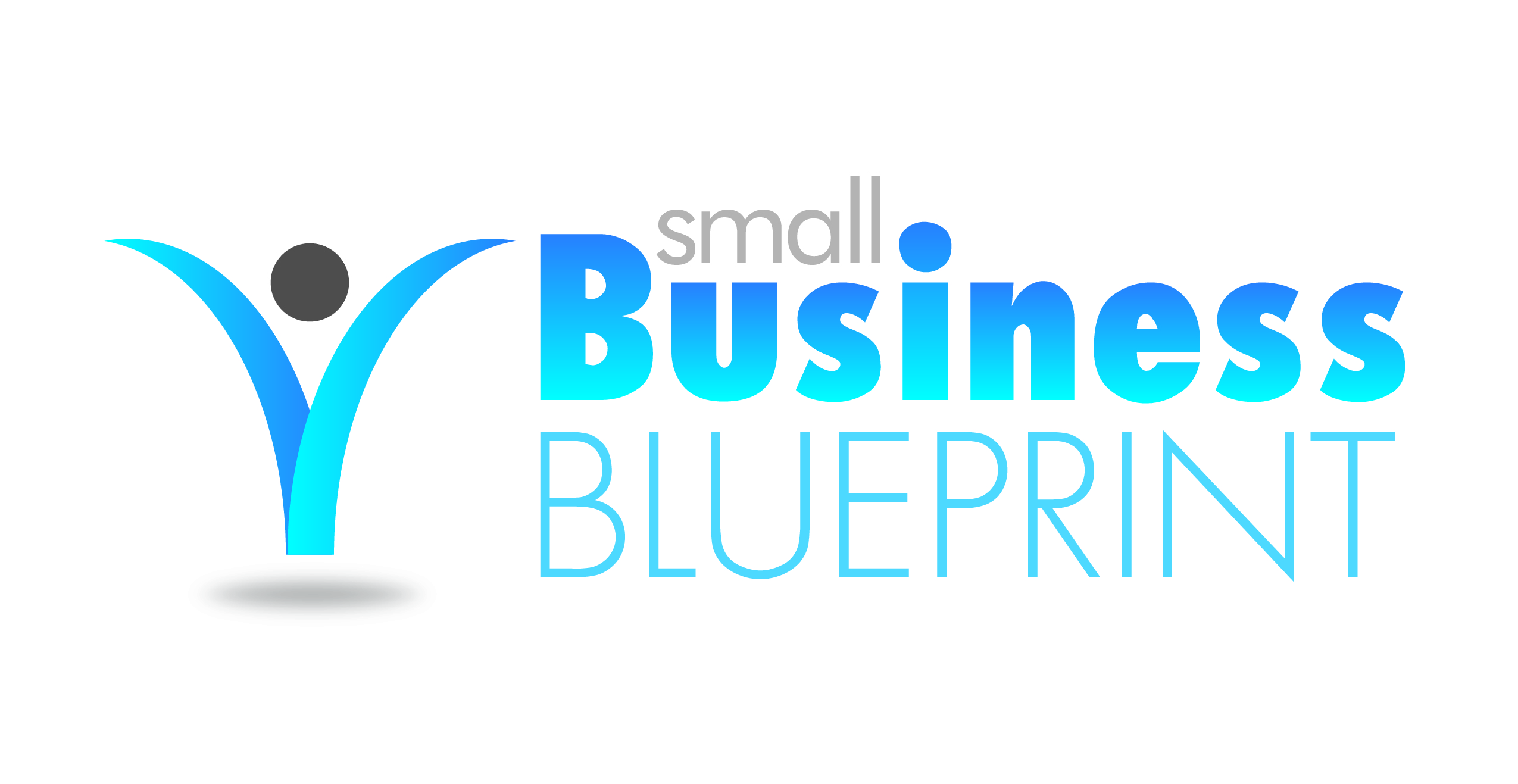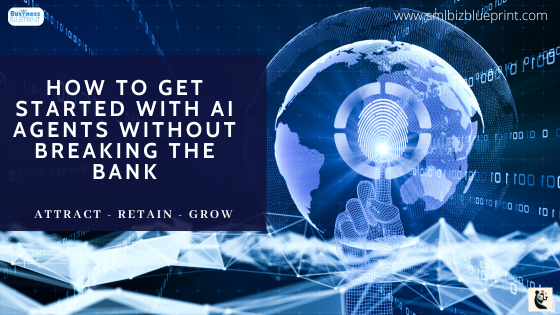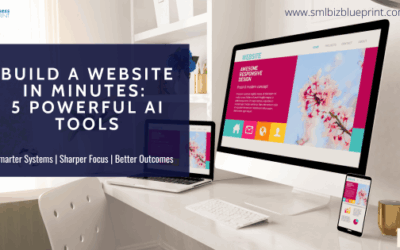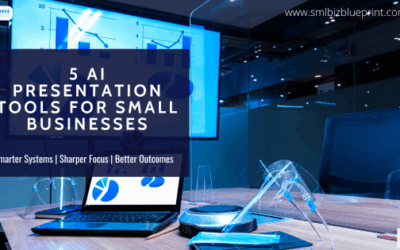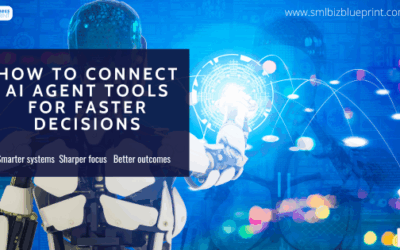Getting started with AI agents might sound like a luxury reserved for big corporations, but the truth is that these powerful tools are now within reach for small businesses, too.
Studies show that 62% of small businesses already invest in AI tools to streamline operations, boost productivity, and enhance customer experiences (Source: Gartner).
However, the perception that AI is expensive or overly complex often deters business owners from exploring its potential.
We understand your challenges—tight budgets, limited resources, and the constant demand to stay competitive in a fast-paced market.
This guide focuses on helping you start with AI agents without breaking the bank. Whether you’re looking to automate repetitive tasks, enhance customer service, or optimise your marketing efforts
We’ll show you affordable, actionable strategies and tools to make AI work for you.
By the end of this post, you’ll discover:
- What are AI agents, and how can they revolutionise your business?
- The most cost-effective tools to get started.
- Practical steps for implementation, even if you’re not tech-savvy.
- How to measure ROI and scale your AI solutions as your business grows.
Let’s dive in and show you how affordable AI solutions can empower your business to achieve more with less.

#1 What Are AI Agents and Why Do Small Businesses Need Them?
AI agents are transforming how businesses operate, but what exactly are they?
Simply put, AI agents are software programs designed to perform specific tasks by mimicking human intelligence. They can process information, make decisions, and learn over time.
Unlike traditional software that requires manual inputs, AI agents operate autonomously within predefined parameters, making them invaluable for businesses looking to save time, reduce costs, and improve efficiency.
For small businesses, AI agents provide opportunities that were once exclusive to large corporations.
From automating customer inquiries to managing inventory, AI agents can take over repetitive tasks, enabling small teams to focus on strategic, high-value activities.
Why AI Agents Are Essential for Small Businesses
Cost Efficiency: AI agents reduce the need for manual labour by automating routine processes like scheduling, data entry, and basic customer service. This lowers operational costs, allowing you to reinvest savings into other business areas.
24/7 Availability: Unlike employees who work limited hours, AI agents operate around the clock. For example, a chatbot can respond to customer inquiries anytime, improving your customer service without additional staffing costs.
Enhanced Productivity: With AI handling mundane tasks, your team can focus on creative problem-solving, strategy, and innovation. This increases overall productivity and positions your business for growth.
Personalisation: AI agents use data to tailor experiences, such as personalising email campaigns or offering recommendations based on customer preferences. This boosts engagement and builds stronger relationships with your audience.
Tips
- Identify Repetitive Tasks: Look for time-consuming tasks in your business, such as answering FAQs, scheduling appointments, or processing orders. These are ideal candidates for AI automation.
- Start Small: You don’t need to overhaul your entire operation at once. Begin with one area, such as customer service, using an affordable AI chatbot, and expand as you see results.
- Leverage Free Tools: Experiment with free or low-cost AI platforms like ChatGPT or HubSpot’s free CRM to understand how AI can integrate into your business workflows without financial risk.
By taking these steps, you’ll demystify AI and unlock its potential to streamline operations and help your small business thrive.
#2 Top Affordable AI Tools to Automate Your Business Workflows
Small businesses can harness the power of AI without overspending by choosing the right tools tailored to their needs. These tools help automate repetitive tasks, enhance customer engagement, and streamline operations, all while keeping costs low.
Here’s a look at the top affordable AI solutions:
Make (formerly Integromat)
Purpose: Automates complex workflows by connecting apps and services without requiring code.
Benefits: Make allows businesses to create detailed automation scenarios, such as integrating e-commerce platforms, updating CRMs, and managing customer notifications.
Cost: Free plan available; paid plans start at $9/month.
ChatGPT by OpenAI
Purpose: Simplifies customer communication, content creation, and internal processes.
Benefits: ChatGPT handles inquiries, drafts emails, and generates blog posts, reducing the need for dedicated staff for these tasks.
Cost: Free tier available; premium starts at $20/month.
Zapier
Purpose: Links apps and automates workflows with “Zaps,” small automation processes.
Benefits: Zapier is ideal for automating repetitive tasks like email follow-ups or social media scheduling.
Cost: Free plan available; premium plans start at $19.99/month.
HubSpot Free CRM
Purpose: Tracks customer interactions, organises leads, and manages sales pipelines.
Benefits: HubSpot’s free CRM includes email marketing tools, website activity tracking, and appointment scheduling.
Cost: Free for basic features; advanced capabilities start at $50/month.
Canva’s AI-Powered Design Tools
Purpose: Creates marketing materials using pre-designed templates and AI suggestions.
Benefits: Perfect for non-designers, Canva’s AI tools make creating polished visuals for social media and marketing campaigns easy.
Cost: Free version available; Pro starts at $12.99/month.
Grammarly
Purpose: Improves written communication by checking grammar, tone, and style.
Benefits: Grammarly’s AI ensures that emails, blog posts, and social media captions are polished and professional.
Cost: A free version is available; premium plans start at $12/month.
Why These Tools Work for Small Businesses
Flexibility: Many of these tools, like Make and Zapier, allow you to build custom workflows to suit your unique needs.
Affordability: With free or low-cost tiers, they enable small businesses to test and refine their AI strategies without financial risk.
Time Savings: Automating repetitive processes frees up valuable time for more strategic tasks.
Tips
- Combine Tools for Greater Efficiency: Use Make alongside other tools like ChatGPT or HubSpot to create seamless workflows, such as automating lead capture and follow-ups.
- Start Small with High-Impact Tasks: Identify a single process, such as appointment scheduling or inventory management, to automate and measure the results.
- Regularly Review Workflows: As your business grows, reassess your automations to ensure they align with your changing goals.
With tools like Make and the others listed here, small businesses can implement robust AI-driven workflows, saving time and money while driving growth.
Start experimenting today to see how these tools can transform your business.
#3 How to Implement AI Agents Without Technical Expertise
For many small business owners, the idea of implementing AI agents might seem daunting, especially without a technical background. The reality, however, is that modern AI tools are designed to be user-friendly, making it easier than ever to get started.
With a step-by-step approach, you can integrate AI agents into your workflows without hiring an IT expert or investing in expensive solutions.
Step-by-Step Guide to Implementing AI Agents
Identify Repetitive Tasks in Your Business
Start by listing the repetitive tasks that consume time and resources.
Examples include:
Responding to frequently asked customer inquiries.
Scheduling appointments or managing calendars.
Processing invoices or updating inventory.
These tasks are ideal candidates for automation because they follow clear, repetitive patterns that AI agents can handle efficiently.
Choose the Right AI Tool for the Job
Once you’ve identified tasks, research AI tools tailored to your needs.
Look for options that are:
User-Friendly: Tools like ChatGPT, Make, and Zapier require no coding skills and come with intuitive interfaces.
Scalable: Select tools that can grow with your business, offering advanced features as your needs evolve.
Affordable: Many AI platforms offer free plans or trial periods, allowing you to experiment without committing upfront.
Start Small and Test Your Workflow
Begin with one simple process to build confidence and measure results.
For example:
Implement a chatbot like ChatGPT to handle FAQs on your website.
Use Make to create a workflow that connects your email marketing platform with your CRM.
Set up a Zapier “Zap” to send automatic follow-up emails after a customer purchases a product.
Testing these workflows ensures that the AI agent functions as expected and delivers value.
Train and Monitor Your AI Agent
Even the most user-friendly AI tools require initial setup and periodic monitoring.
Spend time:
Customising responses for chatbots to align with your brand voice.
Adjusting workflows based on performance metrics or feedback.
Reviewing reports generated by the AI to identify potential improvements.
Remember, AI tools get better over time with proper configuration and use.
Why This Approach Works
Low Barrier to Entry: No coding or technical expertise is required, making these tools accessible to any business owner.
Time Savings: Automating repetitive tasks lets you focus on higher-value activities like strategy and customer engagement.
Cost Efficiency: With free and affordable tools, you can implement AI without overextending your budget.
Tips
- Leverage Templates: Many tools, like Make and Zapier, provide pre-built templates for common workflows (e.g., lead follow-up emails or social media scheduling). These can save time and simplify setup.
- Focus on One Use Case: Avoid overwhelming yourself by automating one task first. For instance, a chatbot can be used to handle customer inquiries before expanding into marketing automation.
- Take Advantage of Support: Most platforms offer tutorials, guides, and customer support to help you navigate setup. Don’t hesitate to use these resources.
Even the least tech-savvy business owners can implement AI agents by following these steps and tips.
Start small, measure results, and scale your automation efforts as you gain confidence. The benefits—time savings, reduced costs, and enhanced efficiency—are worth the effort.
Stay Ahead with Pulse
Don’t just keep up—get ahead.
Subscribe to Pulse and discover how to save time, increase efficiency, and achieve your business goals with AI and automation.
#4 AI Use Cases: Automating Customer Service, Marketing, and More
AI agents have become indispensable for small businesses as they streamline operations and enhance customer interactions.
From automating customer service to optimising marketing campaigns, AI can significantly improve efficiency and deliver measurable results.
Here’s how AI is transforming key areas of business operations:
Automating Customer Service
How It Works: AI-powered chatbots handle routine inquiries like FAQs, order tracking, and appointment scheduling. These tools provide instant responses, reducing wait times and improving customer satisfaction.
Benefits:
Operates 24/7, ensuring customers always receive assistance.
Frees up human staff to focus on more complex queries.
Enhancing Marketing Efforts
How It Works: AI tools analyse customer data to create personalised marketing campaigns. They can segment audiences, automate email marketing, and optimise ads in real time.
Benefits:
Increases engagement through tailored messaging.
Saves time by automating repetitive tasks like email follow-ups.
Streamlining Operations
How It Works: AI automates backend processes like inventory management, invoicing, and data entry. These tools integrate with existing systems to minimise manual errors and ensure accuracy.
Benefits:
Reduces administrative overhead.
Speeds up routine workflows.
Why AI Use Cases, Work for Small Businesses
Increased Productivity: AI takes over time-consuming tasks, allowing staff to focus on higher-value work.
Cost Savings: Automating workflows reduces the need for additional staff or external support.
Improved Customer Experience: AI provides fast, consistent service, enhancing customer satisfaction and loyalty.
Tips
- Start with Customer Service: Implement a chatbot on your website or social media to handle common inquiries. Tools like ChatGPT or Zendesk AI are great starting points.
- Experiment with Marketing Automation: Use platforms like HubSpot or Mailchimp to automate email campaigns and track performance metrics.
- Streamline Operations: Explore tools like Make or Zapier to connect apps and automate backend processes like syncing orders with your inventory system.
By focusing on these key areas, small businesses can harness AI to save time, reduce costs, and provide exceptional service. Start with one use case, measure the impact, and expand as your comfort with AI grows.
The potential benefits are too significant to ignore.
#5 Free and Open-Source AI Resources to Get You Started
For small businesses just beginning their AI journey, free and open-source tools offer an excellent way to experiment without financial risk. These resources provide powerful functionality, flexibility, and community support, enabling you to explore AI solutions tailored to your business needs.
From chatbots to machine learning frameworks, here are some of the best options to kickstart your AI adoption.
TensorFlow
What It Is: TensorFlow is a popular open-source machine learning framework developed by Google.
How It Helps:
Allows businesses to create custom AI models for tasks like data analysis, image recognition, or predictive analytics.
Offers a beginner-friendly library called TensorFlow Lite for simple applications.
Hugging Face
What It Is: Hugging Face provides open-source tools for natural language processing (NLP).
How It Helps:
Ideal for creating AI chatbots, text summarisation, or language translation tools.
Comes with pre-trained models to simplify implementation.
OpenAI API (Free Tier)
What It Is: OpenAI’s API provides access to GPT-based models for tasks like content generation and customer communication.
How It Helps:
Easy to integrate into websites or applications for chatbots and text analysis.
Free credits allow businesses to test the platform without upfront costs.
RapidMiner
What It Is: A free data science platform for analysing data and creating predictive models.
How It Helps:
Simplifies data preparation and visualisation.
No coding is required, making it perfect for beginners.
Rasa
What It Is: Rasa is an open-source framework for building AI chatbots.
How It Helps:
Enables businesses to design and customise conversational AI without relying on third-party platforms.
Offers detailed documentation and active community support.
Why Open-Source AI Tools Are Great for Small Businesses
Cost-Effective: Many open-source tools are free, allowing you to explore AI without financial constraints.
Customisable: These tools can be tailored to meet specific business needs, offering greater flexibility than pre-packaged solutions.
Community Support: Active developer communities provide tutorials, forums, and updates, making it easier to implement and troubleshoot.
Tips
- Start Small with Pre-Trained Models: Use tools like Hugging Face or OpenAI API to test AI capabilities without building models from scratch.
- Leverage Tutorials and Communities: Platforms like TensorFlow and Rasa have extensive documentation and active forums to guide beginners.
- Combine Open-Source with No-Code Tools: Pair open-source frameworks with tools like Make or Zapier to automate workflows seamlessly.
These free and open-source resources allow small businesses to begin their AI journey with minimal investment.
Experiment with different tools, identify what works best for your operations, and build confidence in integrating AI into your workflows. The possibilities are endless, and the cost of entry is within everyone’s reach.
#6 How to Measure ROI and Scale AI Solutions on a Budget
Implementing AI agents can revolutionise your business, but measuring their return on investment (ROI) and scaling your solutions strategically to maximise value is crucial.
Understanding how AI impacts your bottom line helps you refine your approach, justify costs, and ensure you maximise your investment.
Measuring ROI for AI Agents
Key Metrics to Track
Time Savings:
Quantify the hours saved by automating repetitive tasks, such as customer inquiries or inventory management.
Cost Reduction:
Calculate the decrease in labour or operational costs after implementing AI.
Revenue Growth:
Track increases in sales or lead conversion rates driven by AI-powered marketing or customer service.
Customer Satisfaction:
Use feedback and Net Promoter Scores (NPS) to evaluate improvements in user experience.
Strategies for Scaling AI Solutions
Start Small and Expand Gradually
Focus on one area, such as automating email responses or scheduling, to measure impact before expanding to other processes.
Choose Scalable Tools
Opt for AI platforms that offer flexible pricing and advanced features as your business grows. Tools like Make, Zapier, and HubSpot provide affordable entry points with room to expand.
Optimise and Iterate
Regularly review performance metrics to identify bottlenecks or inefficiencies.
Affordable Scaling Tips
Leverage Existing Tools:
Explore upgrades or integrations within your current stack instead of buying new software.
Explore Pay-As-You-Go Options:
Many platforms, such as OpenAI’s API, allow you to scale usage based on demand, avoiding unnecessary expenses.
Automate Across Departments:
Apply AI to multiple areas like customer service, marketing, and operations to amplify benefits without duplicating costs.
Why Measuring and Scaling AI is Crucial
Maximised ROI:
Tracking tangible outcomes ensures that every dollar invested in AI works for your business.
Controlled Costs:
Gradual scaling prevents overspending while optimising resource allocation.
Continuous Improvement:
Monitoring results allow you to refine processes, making your AI solutions more efficient over time.
Tips
- Use Analytics Tools: Platforms like Google Analytics and HubSpot provide insights into traffic, conversions, and customer interactions, helping you tie results to AI efforts.
- Conduct Monthly Reviews: Regularly assess the performance of AI solutions to ensure they’re meeting your goals and delivering value.
- Set Benchmarks: Establish clear KPIs (Key Performance Indicators) for each AI tool, such as response time reduction for chatbots or lead conversion rates for marketing automation.
By measuring ROI and scaling AI solutions carefully, small businesses can maximise the impact of their investments while staying within budget.
Start by tracking results from one AI implementation and use insights to expand strategically, ensuring long-term success and sustainable growth.

#7 Avoiding Common Pitfalls: Overcoming AI Adoption Challenges
While AI agents offer significant benefits for small businesses, implementing them can come with challenges.
From data security concerns to selecting the wrong tools, knowing these potential pitfalls helps you navigate the process smoothly and ensures your AI solutions deliver real value.
Challenge: Lack of Technical Knowledge
The Issue:
Many small business owners worry they lack the expertise to set up and manage AI tools.
The Solution:
Choose tools with user-friendly interfaces and templates, like Make or Zapier.
Take advantage of most AI platforms’ tutorials, guides, and customer support.
Challenge: Selecting the Wrong Tools
The Issue:
Choosing tools that don’t align with your business needs can waste time and resources.
The Solution:
Identify specific tasks to automate before selecting tools.
Look for scalable solutions, such as HubSpot or ChatGPT, that grow with your business.
Challenge: Privacy and Data Security
The Issue:
AI tools often rely on sensitive customer or business data, raising concerns about data breaches.
The Solution:
Choose platforms with strong encryption and data protection policies.
Regularly update software and review privacy settings.
Challenge: Unrealistic Expectations
The Issue: Expecting instant results or viewing AI as a one-size-fits-all solution can lead to disappointment.
The Solution:
Set realistic goals and timelines for your AI projects.
Start small with one process, then expand based on measurable results.
Why Addressing Challenges is Essential
Cost Efficiency:
Avoiding costly mistakes ensures your AI investment delivers maximum ROI.
Smoother Integration:
Being prepared helps you implement AI seamlessly, minimising disruption to your business.
Long-Term Success:
Addressing these pitfalls upfront builds a strong foundation for scaling AI solutions over time.
Tips
- Start with a Pilot Project: Test a single AI tool or process to assess its impact before committing to broader implementation.
- Seek Expert Advice: Contact customer support or AI consultants if you’re unsure about selecting or setting up tools.
- Regularly Review Your AI Strategy: Schedule periodic check-ins to evaluate your AI tools’ performance and adjust as needed.
By proactively addressing these challenges, small businesses can unlock the full potential of AI agents while avoiding common missteps.
The key is to start small, focus on measurable results, and continuously refine your approach as you gain experience.
#8 The Future of AI for Small Businesses: What to Expect
AI is evolving rapidly, and small businesses stand to gain even more as the technology becomes increasingly accessible, affordable, and powerful.
Staying ahead of these trends can position your business to leverage AI for enhanced efficiency, better customer experiences, and competitive advantage.
Democratization of AI
What It Means:
AI tools are becoming easier to use, requiring little to no technical expertise. No-code and low-code platforms like Make and Zapier are leading the way in simplifying complex workflows.
How It Benefits Small Businesses:
Allows you to integrate AI without hiring specialists.
Encourages experimentation with AI tools at minimal cost.
Advanced Personalization
What It Means:
AI’s ability to analyse data and predict customer behaviour will continue to improve, enabling businesses to deliver hyper-personalized experiences.
How It Benefits Small Businesses:
Boosts customer loyalty through tailored recommendations and communication.
Drives sales by offering products or services based on real-time insights.
Integration with IoT (Internet of Things)
What It Means:
AI and IoT will work together to create smarter, automated systems, from inventory management to energy-saving solutions.
How It Benefits Small Businesses:
Reduces operational costs through smarter energy use or inventory tracking.
Enhances customer experiences with innovative solutions like smart kiosks or automated delivery tracking.
Predictive Analytics for Decision-Making
What It Means:
AI-powered analytics tools will help businesses make data-driven decisions by forecasting trends, customer behaviour, and market opportunities.
How It Benefits Small Businesses:
Provides actionable insights to guide marketing, inventory, and staffing strategies.
Reduces risks by identifying potential challenges in advance.
Why Embracing AI Trends is Critical
Competitive Edge:
Businesses that adopt and adapt to AI trends early will outperform those that lag behind.
Efficiency Gains:
Leveraging advancements in AI and IoT reduces manual effort and streamlines operations.
Customer Expectations:
Customers will expect personalised, real-time, and seamless interactions as AI becomes more prevalent.
Tips
- Stay Informed: Follow industry news, blogs, and webinars to stay updated on emerging AI trends relevant to your business.
- Experiment with Scalable Tools: Choose AI platforms that offer advanced features as your needs grow, ensuring long-term viability.
- Invest in Data: Begin collecting and organising customer and operational data now, as it will be the foundation for future AI-driven insights.
By preparing for these future trends, small businesses can keep pace with technological advancements and unlock new opportunities for growth and innovation.
The future of AI is bright, and the time to embrace it is now.
Get the Tools for Success
Don’t just read about growth—achieve it!
Join our newsletter for exclusive tips, tools, and strategies to take your business to the next level.
Conclusion
Embracing AI agents doesn’t have to be intimidating or costly.
As we’ve explored, small businesses can leverage AI tools to automate tasks, enhance customer experiences, and streamline operations without breaking the bank.
By starting small, focusing on affordable solutions, and scaling strategically, you can unlock the transformative potential of AI while keeping your budget in check.
Let’s recap the key points covered in this guide:
- Understanding AI Agents: They’re versatile tools that can handle repetitive tasks, improve efficiency, and free up your time for strategic activities.
- Affordable Tools: Solutions like Make, ChatGPT, and Zapier offer powerful features at minimal cost.
- Implementation Strategies: Start with a single use case, leverage tutorials, and optimise workflows for success.
- Use Cases: From customer service chatbots to marketing automation, AI agents can drive measurable results in multiple business areas.
- Open-Source Resources: Tools like TensorFlow and Hugging Face provide free access to cutting-edge AI capabilities.
- Measuring ROI and Scaling: Track key metrics to evaluate success and scale your solutions gradually for sustained growth.
- Overcoming Challenges: Address common pitfalls like data privacy and unrealistic expectations by planning thoughtfully.
- Future Trends: Stay ahead by preparing for advancements like predictive analytics, IoT integration, and hyper-personalization.
Now is the perfect time to take your first steps with AI agents.
Start small, experiment with free tools, and focus on automating one process that will have the biggest impact on your business.
The future of AI is bright—and it’s within your reach. Take the leap today and watch your business thrive with the power of AI agents.
FAQs
Q1: What are AI agents, and how can they help my small business?
A1: AI agents are software tools designed to perform tasks like answering customer inquiries, automating workflows, and analysing data. For small businesses, they save time, reduce operational costs, and enhance productivity by handling repetitive tasks.
Q2: Are AI agents expensive to implement?
A2: Not necessarily. Many AI tools offer free or low-cost plans to get started. For example, platforms like Make, ChatGPT, and HubSpot Free CRM provide powerful features without requiring significant upfront investment.
Q3: Do I need technical expertise to use AI agents?
A3: No. Many modern AI tools, featuring intuitive interfaces and pre-built templates, are designed for non-technical users. Resources like tutorials, guides, and customer support are often available to help you set up and manage these tools.
Q4: What tasks can AI agents automate in my business?
A4: AI agents can handle a variety of tasks, including:
Responding to FAQs via chatbots.
Scheduling appointments and sending reminders.
Managing inventory and automating email marketing campaigns.
Generating personalised product recommendations for customers.
Q5: How do I measure the ROI of AI agents?
A5: Track metrics such as:
Time saved by automating repetitive tasks.
Reduction in labour or operational costs.
Increased sales or lead conversion rates.
Improved customer satisfaction through faster response times.
Q6: Are there free AI tools I can try before committing to paid solutions?
A6: Yes. Free tools like TensorFlow, Hugging Face, and OpenAI API allow you to experiment with AI capabilities without financial risk. Many commercial platforms also offer free plans or trials.
Q7: What should I consider before scaling AI solutions in my business?
A7: Before scaling, ensure that:
The tool aligns with your specific business needs.
You’ve measured its performance and ROI.
The platform offers scalable features to accommodate future growth. Start by automating one task, evaluate its impact, and expand gradually.
Other Articles
Maximise Your 2025 SEO Results with These Simple Tips
Transform Your Business with These 13 Marketing Tips for the New Year
9 Proven Content Ideas to Keep Your Brand Active While on Holidays
